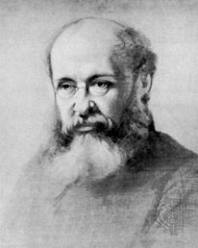“The claims of friendship are very strong, but those of love are paramount.”
A witty and incisive look at love, money, and marriage, this 1864 novel is the fifth of Anthony Trollope’s six Barsetshire novels, with some of his best characters. Lily Dale, somewhat reminiscent of Jane Austen’s women, lives with her widowed mother and sister Bell in the Small House on her uncle’s estate. Both girls are of marriageable age, though they have no fortunes, and as the novel develops, the reader sees the extent to which marriage in Victorian England is often a business transaction, negotiated by families to ensure their daughters’ welfare and continuing standard of living. Because Lily and Bell have no fortunes, their courtships become the primary vehicle through which Trollope examines the contrasts between marriages for love and marriages for convenience.
incisive look at love, money, and marriage, this 1864 novel is the fifth of Anthony Trollope’s six Barsetshire novels, with some of his best characters. Lily Dale, somewhat reminiscent of Jane Austen’s women, lives with her widowed mother and sister Bell in the Small House on her uncle’s estate. Both girls are of marriageable age, though they have no fortunes, and as the novel develops, the reader sees the extent to which marriage in Victorian England is often a business transaction, negotiated by families to ensure their daughters’ welfare and continuing standard of living. Because Lily and Bell have no fortunes, their courtships become the primary vehicle through which Trollope examines the contrasts between marriages for love and marriages for convenience.
When Lily falls hopelessly in love with Adolphus Crosbie, a young friend of her cousin Bernard, he returns her affection. Thinking that her uncle will give her a substantial dowry, Crosbie then proposes, and she accepts. When he discovers there will be no dowry, Crosbie suddenly wonders how he will support Lily in the manner to which he would like to become accustomed. One week after the betrothal, he has left Allington and become engaged to the wealthy, but cold, Lady Alexandrina De Courcy. Though the heartbroken Lily believes that she can never love another, the way she has loved Adolphus, she resolves (somewhat priggishly) to lead a good life and do good works. Her sister Bell refuses marriage to a cousin who had expected to to collect the dowry from their uncle.
 Other subplots continue this money/marriage theme. Johnny Eames, a young London clerk, loves Lily to the same degree that she loves Adolphus Crosbie, but he has made a rash promise to marry Amelia Roper, the daughter of his boarding house owner. Marriage to Johnny would greatly improve Amelia’s way of life. As the fates of Lily, Bell, Adolphus Crosbie, Lady Alexandrina, Johnny Eames, Amelia Roper, and their parents and friends intertwine, Trollope depicts a cross-section of society, their attitudes toward love and marriage, and the economic impact of marriage. Minor characters reveal their attitudes toward work and their employers, and Trollope uses these to show sly parallels between marriage and work.
Other subplots continue this money/marriage theme. Johnny Eames, a young London clerk, loves Lily to the same degree that she loves Adolphus Crosbie, but he has made a rash promise to marry Amelia Roper, the daughter of his boarding house owner. Marriage to Johnny would greatly improve Amelia’s way of life. As the fates of Lily, Bell, Adolphus Crosbie, Lady Alexandrina, Johnny Eames, Amelia Roper, and their parents and friends intertwine, Trollope depicts a cross-section of society, their attitudes toward love and marriage, and the economic impact of marriage. Minor characters reveal their attitudes toward work and their employers, and Trollope uses these to show sly parallels between marriage and work.
Trollope, who comments on writing throughout the novel, has more in common with the social realism of George Eliot than with the melodrama of Wilkie Collins and Charles Dickens. His use of Mrs. Roper, Amelia’s mother, as a character with financial troubles is realistic without being maudlin, and Adolphus Crosbie, the bounder, is also realistic in his naive assumptions and his regrets. Filled with fascinating reflections on all levels of society, this novel also includes references to the Pallisers and to a few characters from previous Barsetshire novels. Outstanding, and thoroughly enjoyable.
Also reviewed here are six additional novels by Trollope. (Just click on the Titles or Authors tabs at the top of this page.)
